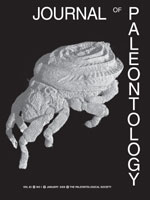The Actinoceramus sulcatus lineage (Parkinson, 1819) (Bivalvia: Inoceramidae) is a very distinctive and abundant component of late Albian (Early Cretaceous) molluscan assemblages that is found throughout Europe, Central Asia, Japan and the Far East of Russia, southern and western North America, South Africa, and possibly India, in a range of shallow- to deep-marine facies. The lineage encompasses a wide and continuous range of morphologies that provide evidence of phyletic evolution at varying rates combined with large ecophenotypic plasticity within populations. The evolution of A. sulcatus marks the oldest appearance of well-developed radial folds and sulci within the Inoceramidae. The range of morphological variation makes formal taxonomic subdivision of the group problematic. Here we use a combination of formal successional subspecies and informal morphotypes to subdivide the lineage into the following taxa: A. sulcatus forma sulcatus, A. sulcatus forma subsulcatus (Wiltshire, 1869), A. sulcatus forma munsoni (Cragin, 1894), and A. sulcatus biometricus Crampton, 1996. Within these taxa and morphotypes, we synonymise a large number of earlier names that have been applied to variants within the lineage. Each of the forms recognized has biostratigraphic utility and we describe four new lineage biozones, in ascending order: A. concentricus parabolicus, A. sulcatus, A. sulcatus forma munsoni, and A. sulcatus biometricus biozones. The lowest occurrence of A. sulcatus is approximately coincident with the base of the upper Albian as currently defined, at least throughout most of Europe, and this datum provides a valuable tool in correlation. The nature of radial folds within the A. sulcatus lineage poses interesting but still unanswered questions regarding shell morphogenesis in bivalves and the functional significance (if any) of radial folds in the Inoceramidae.
How to translate text using browser tools
1 January 2009
Taxonomy and Biostratigraphy of the Late Albian Actinoceramus sulcatus Lineage (Early Cretaceous Bivalvia, Inoceramidae)
James S. Crampton,
Andy S. Gale
ACCESS THE FULL ARTICLE

Journal of Paleontology
Vol. 83 • No. 1
January 2009
Vol. 83 • No. 1
January 2009




